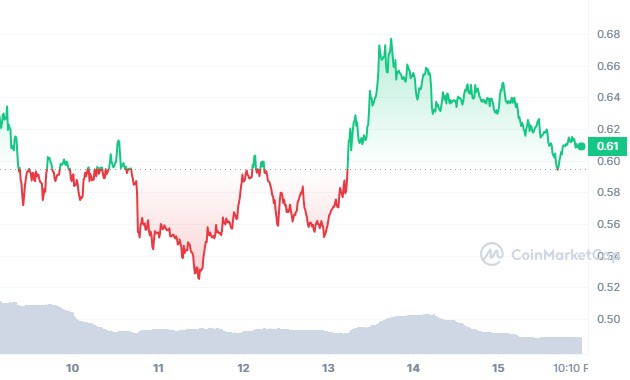Cardano (ADA) is forming a unique pattern, specifically identified as a descending triangle within shorter time frames. In a recent post on X, the distinguished crypto analyst Ali delved into the analysis, emphasizing Cardano’s development of a descending triangle on these smaller time frames. This pattern holds the potential for substantial implications on the coin’s future path.
Emphasizing the pivotal level, the analyst underlined the significance of maintaining a consistent closing above $0.638 for Cardano. A successful breach of this resistance threshold might incite a bullish breakout, propelling ADA toward the $0.700 milestone.
As of the latest update, the current price of Cardano stands at $0.6135, with a 24-hour trading volume reaching a substantial $816,292,314. Over the past day, ADA has experienced a 5.02% decline, while the weekly chart reflects a 2.73% increase, showcasing the inherent volatility in the crypto space.

Cardano maintains its position as the 8th largest cryptocurrency globally, boasting a market cap of $2 billion. The circulating supply of ADA coins is reported to be 35,334,923,354, with a maximum supply capped at 45,000,000,000 ADA coins.
Cardano’s Weekly Progress
The Cardano network is demonstrating significant advancements in its recent progress. According to the latest weekly development report, substantial strides have been made across multiple aspects. The core technology teams have introduced node v.8.7.2, implementing CLI refactoring from SanchoNet to mainnet. This transition lays the groundwork for the upcoming v.9.0 release, indicating a promising trajectory for the network’s evolution.
Notable enhancements include improvements in the P2P networking layer and an emphasis on bug fixing and code optimizations for mainnet readiness.
The Lace team contributed to wallet and service improvements with the release of Lace 1.8, enhancing stake pool rewards performance and addressing bugs. The Plutus Core team introduced common subexpression elimination, resulting in notable script size and cost reductions. Meanwhile, the Marlowe team focused on refining validators, updating lessons, and enhancing support for TS-SDK.
Scaling developments included the release of Hydra v.0.14.0, bolstering network resilience, and optimizing the layer 1 protocol. The Mithril team made strides in WASM compilation and advanced threat modeling for P2P networking. Meanwhile, the Voltaire team reflected on a year of accomplishments, emphasizing community collaboration and the upcoming Chang hard fork in 2024, marking a significant milestone in Cardano’s roadmap.
Related Reading | Tether Unveils Robust Anti-Illicit Measures In Letters To U.S. Congress

